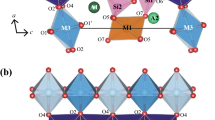Abstract
Ferrous and ferric iron concentrations in feldspars with low total iron content (<0.32 wt% total Fe) were determined from optical and electron paramagnetic resonance (EPR) spectra to better than ±15 percent of the amount present. Optical spectra indicate that Fe2+ occupies two distorted M-sites in plagioclases of intermediate structural state. The linear dependence of the Fe2+/Fe total ratio on An content demonstrates that Fe2+ substitutes for Ca (not Na) so that the number of Ca-sites is a principal factor in iron partitioning in plagioclase. EPR powder spectra show that the number of sites for Fe3+ depends on structural state rather than on plagioclase chemistry. The observed linear correspondence of EPR double-integrated intensities with optical peak areas shows that all Fe3+ is tetrahedrally coordinated in both plagioclase and disordered potassium feldspar. Microcline perthites show, in addition to tetrahedral Fe3+, a signal due to axially coordinated ferric iron, which we associate with formation of hematite inclusions.
Similar content being viewed by others
References
Angel BR, Vincent WE J (1978) Electron spin resonance studies of iron oxides associated with the surface of kaolins. Clays Clay Miner 26:263–272
Bartholomew, RF, Butler RL, Hoover HL, Wu CK (1980) Infrared spectra of a water-containing glass. J Amer Ceram Soc 63:481–485
Bell PM, Mao HK (1972) Measurements of the polarized crystal field spectra of ferrous and ferric iron in seven terrestrial plagioclases. Carnegie Inst Washington Yearb 72:574–576
Bell PM, Mao HK (1973) Optical and chemical analysis of iron in Luna 20 plagioclase. Geochim Cosmochim Acta 37:755–759
Cech F, Misar Z, Povondra P (1971) A green lead-containing orthoclase. Tschermarks Mineral Petrogr Mitt 15:213–231
Coombs DS (1954) Ferriferous orthoclase from Madagascar. Mineral Mag 30:409–427
Davydov AS (1968) Theory of Urbach's rule. Phys Status Solidi 27:51–56
Emmons RC (ed) (1953) Selected petrogenetic relationships of plagioclase. Geol Soc Amer Mem 52:1–142
Faye GH (1969) The optical absorption spectrum of tetrahedrally bonded Fe3+ in orthoclase. Can Mineral 10:112–117
Eaton SS, Eaton GR (1979) Signal area measurements in EPR. Bull Magnetic Resonance 1:130–138
Gaite J-M, Michoulier J (1970) Application de la resonance paramagnetique electronique de l'ion Fe3+ a l'étude de la structure des feldspaths. Bull Soc Fr Mineral Cristallogr 93:341–356
Gay P (1955) The structures of the plagioclase feldspars: VI. Natural intermediate plagioclases. Mineral Mag 31:21–40
Golding RM, Singhasuwich T, Tennant WC (1977) An analysis of the conditions for an isotropic g-tensor in high-spin d5 systems. Mol Phys 34:1343–1350
Golding RM, Kestigian M, Tennant CW (1978) EPR of high-spin Fe3+ in calcium tungstate, CaWO4. J Phys C 11:5041–5049
Goldman DA, Rossman GR (1977) The spectra of iron in orthopyroxene revisited: The splitting of the ground state. Am Mineral 62:151–152
Griscom DL (1973) ESR studies of radiation damage and structure in oxide glasses not containing transition metal group ions: a contemporary overview with illustrations from the alkali borate system. J Non-Crystalline Solids 13:251–285
Gutmann JT, Martin RF (1976) Crystal chemistry, unit cell dimensions and structural state of labradorite megacrysts from Sonora, Mexico. Schweiz Mineral Petrogr Mitt 56:55–64
Hawthorne FC (1983) Quantitative characterization of site-occupancies in minerals. Am Mineral 68:287–306
Höchli U (1963) Electron spin resonance of Fe3+ in feldspars. Proc Colloq AMPERE (Electronic magnetic resonance and solid dielectrics) 12th: 191–197
Hofmeister AM (1984) A spectroscopic and chemical study of the coloration of feldspar by irradiation and impurities, including water. Ph. D. Thesis, California Institute of Technology, Pasadena. California
Manning PG (1970) Racah parameters and their relationship to lengths and covalences of Mn2+ and Fe3+ oxygen bonds in silicates. Can Mineral 10:677–688
Marfunin AS, Bershov LV, Meilman ML, Michoulier J (1967) Paramagnetic resonance of Fe3+ in some feldspars. Schweiz Mineral Petrogr Mitt 47:13–20
Matyash IV, Bagmut NN, Litovchenko AS, Proshko V Ya (1982) Electron paramagnetic resonance study of new paramagnetic centers in microcline perthites from pegmatites. Phys Chem Minerals 8:149–152
Niebuhr HH, Zeira S, Hafner SS (1973) Ferric iron in plagioclase crystals from anorthosite 15415. Proc Lunar Sci Conf 4th Supp 4 GCA 1:971–982
Scala CM, Hutton DR, McLaren AC (1978) NMR and EPR studies of some chemically intermediate plagioclase feldspars. Phys Chem Minerals 3:33–44
Scholze H (1966) Gases and water in glass. Glass Ind 47:546–551; 622–628
Smith JV (1974) Feldspar minerals. I. Crystal structure and physical properties. II. Chemical and textural properties. Springer Verlag, Berlin Heidelberg New York, pp 627 and 690
Speit B, Lehmann G (1982) Radiation defects in feldspars. Phys Chem Minerals 8:77–82
Spencer E (1937) The potash-soda feldspars. I. Thermal stability. Mineral Mag 24:453–499
Stewart B, Walker GW, Wright TL, Fahey JJ (1966) Physical properties of calcic labradorite from Lake County, Oregon. Am Mineral 51:177–197
Urbach F (1953) The long-wavelength edge of photographic sensitivity and of the electronic absorption of solids. Phys Rev 92:1324
Veremeichik TF, Grechusnikov BN, Varina TM, Sviridov DT, Kalinkina IN, (1974) Absorption spectra and calculation of energylevel diagram of Fe3+ and Mn2+ ions in single crystals of yttrium aluminum garnet, orthoclase, and manganese silicate. Kristallografiya 19:1194–1199, translation: Sov Phys Crystallogr 19:742–744 (1975)
Weeks RA (1973) Paramagnetic spectrum of Ti+3, Fe+3, and Mn+2 in lunar plagioclases. J Geophys Res 78:2393–2401
Wise W (1982) New occurrence of faujasite in southeastern California. Am Mineral 67:794–798
Wu CK (1980) Nature of incorporated water in hydrated silicate glasses. J Amer Ceram Soc 63:453–457
Author information
Authors and Affiliations
Rights and permissions
About this article
Cite this article
Hofmeister, A.M., Rossman, G.R. Determination of Fe3+ and Fe2+ concentrations in feldspar by optical absorption and EPR spectroscopy. Phys Chem Minerals 11, 213–224 (1984). https://doi.org/10.1007/BF00308136
Received:
Issue Date:
DOI: https://doi.org/10.1007/BF00308136




